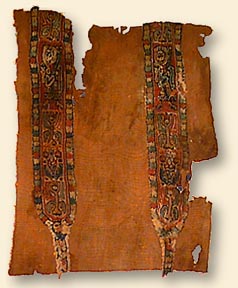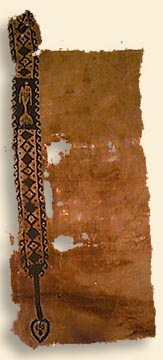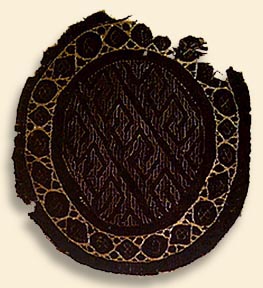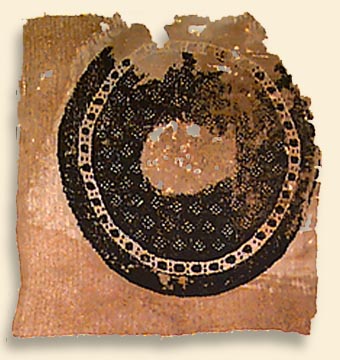

| Contents: Fabrics: The Uses of Fabrics Status Symbols How the Textiles Survived |
Weaving Technology: Materials and Dyes Weaving Techniques Coptic Weavers |
Textiles had various uses in Coptic Egypt. The household uses of textiles included bed sheets and covers, towels, napkins, tablecloths, and carrying sacks. Textiles were used both in households and in public and church buildings as decorative curtains and hangings.

The most common use of textiles was as apparel. The standard form of clothing in Coptic Egypt during Roman times was the tunic, a rectangular shirt-like piece of cloth that fit over the head, and was sometimes fastened at the waist by a belt. Textiles were also used for belts, cloaks, and shawls as well as for burial garments. When mummification was outlawed in the fourth century, the Copts stopped wrapping the bodies with linen strips and began using regular clothing in which to bury the dead. Other textiles such as shawls, bed covers, and curtains were probably used as external wrappings of the dead.
(Click on image to see detail)
Description:
The two clavi are on a brownish yellow background. The clavi is decorated with
dark yellow, dull red, dark blue, light green, and tan. The borders of the clavi
are designed with jewel-like decorations. Inside the identical bands there is
a stylized plant motif, followed by a haloed figure in a robe, carrying a lyre,
followed by three more stylized plant motifs. Materials/Construction: The ground
and the clavi are woven in tapestry, with wool warp and weft. The clavi are
whip-stitched to the plain background. Measurement: 9 x 11 cm. Date: Seventh
century. Accession number: CAS 0389-2409.

For both the pharaonic Egyptians and the Greeks, clothing was indicative of social and economic status. Clothing continued to distinguish between social strata for the Romans. The Roman citizens wore togas and non-citizens wore tunics. For the Copts, tunics were made of plain wool or linen and were decorated with either a single vertical band (clavus) that ran down the center of the garment, or two decorated vertical bands (clavi) that extended over each shoulder down to the knee area or the bottom of the garment, on the front and back. The clavi were decorated and were generally purple. Tunic decorations derived from the army's use of decorations to designate rank during the Roman era.
Description: This fragment of a tunic has part of a purple clavus on the natural yellowish ground. The clavus is decorated with lozenge patterns, interrupted by a rectangle with a dolphin/fish. The border of the clavus is decorated with a spiral wave pattern. The dolphin symbolizes salvation and protection. Fish were used to symbolize Christ. From Shaikh Abada. Materials/Construction: This textile is made of wool, in a tabby weave, with a tapestry insert, woven on grouped warps. Measurement: 15.8 x 38 cm. Date: Fifth century. Accession number: CAS 0389-2418.
Oval Dress Ornament
During the Byzantine period, the tunic evolved into a variation called the dalmatic. The dalmatic was wider and longer and was decorated with round ornaments (roundels) on the sleeves or at the knees, sleeve bands, and neck bands, as well as the clavi. The Byzantines made new regulations to restrict the use of the more luxurious items of silk, purple dye, and gold thread to the imperial classes. The lower classes made imitations on the use of imperial styles, like dyeing red over blue to make an imitation purple. The Copts sometimes removed the colored ornaments from the old and worn-out clothes to reuse them on new clothes.
Description:
This ornament is an orbiculum, an oval ornament placed at the shoulders or knee
area of a garment, thought to guard those vital areas from harm. The pattern
is linear meander bands in tan on a red-purple ground. Materials/Construction:
The motif was woven in the tapestry technique, in fine wool yarn on paired linen
warps. Measurement: 18.5 x 16.5 cm. Date: Late third or early fourth century.
Accession number: CAS 0389-2398.
Textiles
rarely survive in the archaeological record given their organic nature and their
rapidity of decomposition in wet and acidic conditions. It may seem remarkable
that the Coptic textiles have survived, given their old age. But they survived
because of the burial practices of the Copts and the dry climate of Egypt. By
burying the dead fully clothed in the dry sands of Upper Egypt, the textiles
were conserved. The textiles that were preserved were woven for everyday use
rather than explicitly for burial garments. Many of the surviving textiles have
been mended and patched, which testify to the fact that they were worn and used
during life and were not just burial garments.
The two most common materials used by the Copts were linen (made from flax) and wool. The Egyptians used linen from pharaonic times onward. Linen was favored because it is strong and durable. The fibers are smooth and not easily abraded. Flax flourished in Egypt with the fertilizing annual floods of the Nile. Linen could be woven in different levels of quality, from a very fine, sheer fabric, to a thick canvas-like fabric. Around 300 BCE, cotton was introduced from India, silk from China and sheep were imported. However, linen continued to be the most favored fabric because silk was very expensive. During pharaonic times the Egyptians did not use wool because it was regarded to be ritually unclean. Linen garments were also cooler than wool garments, which was important in the hot climate of Egypt.
However wool became common about
the time of the Roman conquest, around 30 BCE. The Romans liked wool and since
Egypt was a major center of textile production for the Roman Empire, wool increased
in use. Wool has an advantage over linen in that it is easily dyed, while linen
must first be soaked in an acidic mordant in order to take on a dye. Wool and
linen were used both alone and in combination together in the same textile.
Most commonly, weavers used linen as the background or main material, as in
the shirt of a tunic, and wool as the material for the colorful narrow bands
(clavi) that descend from the shoulders of the tunic and for the ornaments on
the sleeves and at the knees of the tunic.
The dyes used in the textiles can aid in the dating of textiles because, in general, the earlier Coptic textiles were monochromatic, while the later textiles (from around the sixth century) had more varied colors.

The Copts used dyes made from animal and vegetable compounds. The colors first used by the Copts were purple, red, and yellow. The dyes may reflect the Roman custom of color usage, whereby certain colors indicate social status. Purple was a preferred color, but it was time consuming and expensive to produce. The purple dye was made from the secretions of the purple-shell. This mollusk was only found offshore of Syria, and great quantities were needed to make the dye. Purple was restricted to the court circles in Alexandria, although there were other imitation recipes to make purple dyes.
Description: This squarish fragment has a tan ground with a dark purple roundel. Inside the roundel is a border of circles. The center of the roundel is composed of clusters of nine dots. Purple medallions like this were worn by church and government officials. The wear marks suggest it may have been worn inside out or used as a furniture cover. Materials/Construction: The fragment is made with linen and wool on a linen warp. Made by an important technique, weft loop pile. Measurement: 55 x 58 cm. Date: Fifth or early sixth century. Accession number: CAS 0389-2583.
Red
dye was procured from the madder root and the female coccus insect during early
times. Yellow dye was obtained from weld and saffron, and blue dye was obtained
from woad and indigo. Later on the colors used also include green, which was
made by dyeing yellow over blue.
Reconstruction of the type of looms the ancient Egyptians used can be made from the wall paintings of tombs from the Middle Kingdom and from the burial gifts of miniature models of weavers' workshops. The oldest type of loom appears to have been a horizontal low-warp loom that was attached to the ground with pegs to stretch the fabric. Around 1650-1500 BCE a vertical standing high-warp loom which used weights to stretch the warps was introduced. During the Roman era, the foot-powered draw loom came into use. The draw loom permitted fast mechanized weaving of intricate patterns.

The development of pattern weaving is one of the important achievements of the Coptic weavers that distinguishes their textiles from those of the Ancient Egyptians. Patterned textiles were brought into the mainstream around the time of Alexander the Great's conquest of Egypt in the fourth century BCE. Some Greek textiles were patterned and featured the use of dyed wool. Patterned textiles were valued because their production was quite labor intensive.
Coptic textiles are characterized by the "S-twist" of thread. After washing, the natural flax fibers have an inherent sense of rotation, in the anti-clockwise direction. Therefore, when they are spun into thread, they were twisted in this direction, which is called "S-twist." Wool does not have a tendency to rotation, so it followed convention that wool was also spun in the "S-twist" technique.
The Egyptians used the
weaving techniques of tabby weave, half basket weave, and looped or soumak.
Tabby weave is the simplest form of weaving, consisting of horizontal threads
(weft) interweaving with vertical threads (warp). Soumak had the effect of making
distinct outlines of the designs. Other techniques they used were brocading
and tapestry. The tapestry technique allowed wool decorations to be woven into
the surrounding linen. The Copts invented the flying shuttle technique, which
uses a second shuttle to insert an extra linen weft thread into the fabric.
While during the pharaonic era weavers were associated with temples, Coptic weavers were organized into small workshops in towns, under the supervision of the state. During various phases of history, the weavers were under the control of the Ptolemies, Romans, and Arabs. Alexandria had an imperial center of textile manufacture during the fifth century, and was a trading center from that time onwards. Interestingly, while it was mainly women who were weavers in pharaonic times, it is males who are documented as weavers in the Christian era. When the vertical loom was invented, it was mostly operated by men. Men turned textile making into a commercial industry, although textiles continued to be made domestically.
| Coptic Textiles Home | History of the Copts | Coptic Stylistic Groups | Coptic Weaving Technology |
| Coptic Textiles Collection | Resources | Online Exhibits Home | Anthropology Home |